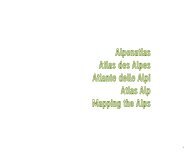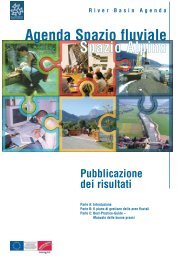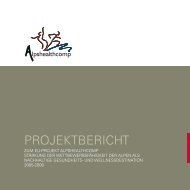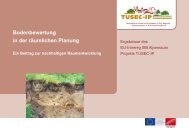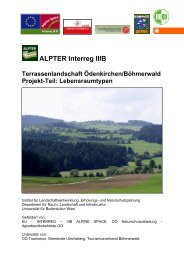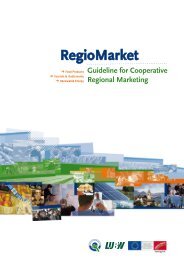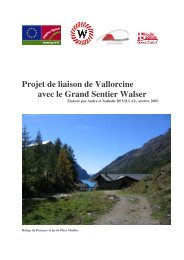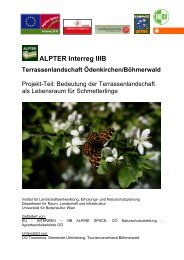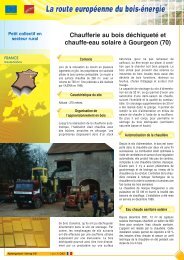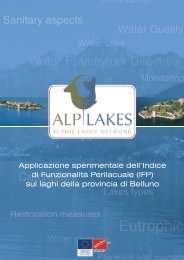WALSERSPRACHE - The four main objectives of the Alpine Space ...
WALSERSPRACHE - The four main objectives of the Alpine Space ...
WALSERSPRACHE - The four main objectives of the Alpine Space ...
Create successful ePaper yourself
Turn your PDF publications into a flip-book with our unique Google optimized e-Paper software.
Elisabetta Fazzini<br />
unknown or obsolete in <strong>the</strong> first <strong>of</strong> two enquiries (and replaced by Italian or Piedmontese<br />
loans), were recorded as still in use in <strong>the</strong> second. It turned out to be next to impossible to draw<br />
isoglosses in <strong>the</strong> Sou<strong>the</strong>rn Walser area. <strong>The</strong> most one could achieve was to detect some degree<br />
<strong>of</strong> kinship between two or more dialects in confined research areas. Analyses were carried out<br />
on single dialects and on similar dialects on a comparative basis. Follows a list <strong>of</strong> works on<br />
this topic (see first bibliographical list). <strong>The</strong> following works are devoted instead to studying <strong>the</strong><br />
Walser lexicon: follows a list <strong>of</strong> works on this topic (see second bibliographical list). For a<br />
broader outlook on scientific studies on Walser minorities in Italy we recommend <strong>the</strong> following<br />
Bibliographies <strong>of</strong> Bibliographies. Follows a list (see third bibliographical list). Born <strong>of</strong> interviews<br />
and direct analysis <strong>of</strong> ga<strong>the</strong>red materials was <strong>the</strong> Comparative Vocabulary <strong>of</strong> Walser<br />
Dialects in Italy, by Elisabetta Fazzini and Costanza Cigni. It required a special method <strong>of</strong><br />
entry indexing and phonetic coding. In <strong>the</strong> meantime <strong>the</strong>re appeared dictionaries in<br />
Gressoney, Issime, Rimella and Formazza. Sergio Gilardino is currently working on <strong>the</strong> dictionary<br />
<strong>of</strong> Alagna. <strong>The</strong> problem is <strong>the</strong> presumable users <strong>of</strong> <strong>the</strong>se dictionaries: whom do <strong>the</strong>y<br />
cater to, and what are <strong>the</strong>y supposed to be useful for, what philosophy should inspire <strong>the</strong>m and<br />
what sources should <strong>the</strong>y draw from. For our Comparative Dictionary we adopted <strong>the</strong> tw<strong>of</strong>old<br />
perspective: comparative-synchronic one for all <strong>the</strong> dialects involved and diachronic one to<br />
evince <strong>the</strong>ir evolution, which rests on recordings over different decades and keeps track <strong>of</strong> <strong>the</strong><br />
original form in ancient and middle German. We made use <strong>of</strong> texts in dialect, different lexical<br />
registers, vocabularies, morphological and lexical analyses, and linguistic atlases. Such a<br />
study can in no way be looked upon as thorough and exhaustive, since it rests on non-homogeneous<br />
sources, including <strong>the</strong> various methods used to ga<strong>the</strong>r data from language informants.<br />
We tried none<strong>the</strong>less to supply a synoptical view <strong>of</strong> <strong>the</strong> lexicon <strong>of</strong> <strong>the</strong>se dialects, while<br />
analysing <strong>the</strong> evolutionary processes that brought about a branch <strong>of</strong> Germanic speech all <strong>of</strong><br />
its own. <strong>The</strong> dictionary includes terms from <strong>the</strong> working and living environments, but we also<br />
find in it agricultural and shepherding words. <strong>The</strong>re are words to be found only in <strong>the</strong> Wallis<br />
region, o<strong>the</strong>rs spread over a wider area and o<strong>the</strong>rs again which are to be found in Sou<strong>the</strong>rn<br />
dialects only. We tried to determine which language was responsible for new moulds, French,<br />
Italian, Piedmontese, Valdôtain, German, French-Provençal. In short, we tried to compile a<br />
work which would prove useful to sort out <strong>the</strong> peculiarities <strong>of</strong> <strong>the</strong>se dialects, <strong>the</strong>ir conservativeness<br />
and <strong>the</strong>ir evolutionary traits. Follows a list <strong>of</strong> dissertations on various Walser dialects. All<br />
<strong>the</strong> ga<strong>the</strong>red materials previously at <strong>the</strong> Department <strong>of</strong> Germanic Studies at <strong>the</strong> University <strong>of</strong><br />
Florence are now at <strong>the</strong> Library <strong>of</strong> <strong>the</strong> University Centre for <strong>the</strong> Study <strong>of</strong> Germanic Dialects at<br />
75



